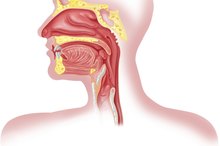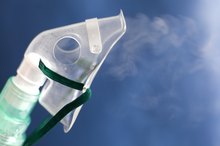What does fact checked mean?
At Healthfully, we strive to deliver objective content that is accurate and up-to-date. Our team periodically reviews articles in order to ensure content quality. The sources cited below consist of evidence from peer-reviewed journals, prominent medical organizations, academic associations, and government data.
- National Institutes of Health: Nasal Flaring
- National Institutes of Health: Skin Discoloration: Bluish
The information contained on this site is for informational purposes only, and should not be used as a substitute for the advice of a professional health care provider. Please check with the appropriate physician regarding health questions and concerns. Although we strive to deliver accurate and up-to-date information, no guarantee to that effect is made.
Reasons for Flaring Nostrils
Nasal flaring, which occurs when the opening of someone's nose enlarges, is a sign that someone is expending increased effort to breathe or is having difficulty breathing 3. Although it often occurs as a function of normal breathing, flaring nostrils can on occasion be a sign of illness or a serious disorder.
If you are experiencing serious medical symptoms, seek emergency treatment immediately.
Agitated or Aroused Emotional States
A flared nostril indicates that a person's heart rate or breathing rate has increased, and can be a sign of emotional stress. In a confrontational situation, flaring nostrils--usually in combination with a curling lip--are a sign that a person is experiencing contempt, disgust or anger, and could be readying himself for combat. The more protruded the flared nostril, the more likely that a person is going to become violent or physical. It could also be a signal that a person is experiencing displeasure or, if he is deep in thought, flaring nostrils could indicate that a person is making a big decision. In a flirtatious context, flaring nostrils--especially with unaccompanied by a curling lip--mean that a person may be romantically interested or sexually aroused.
- A flared nostril indicates that a person's heart rate or breathing rate has increased, and can be a sign of emotional stress.
- In a confrontational situation, flaring nostrils--usually in combination with a curling lip--are a sign that a person is experiencing contempt, disgust or anger, and could be readying himself for combat.
Exercise or Rigorous Exertion
Agonal Breathing Definition
Learn More
The body's respiratory system is responsible for turning oxygen into carbon dioxide that has filled the lungs. During rest, only about a tenth of the lungs are used for breathing. During heavy exertion, such as running or weight lifting, a person needs the whole capacity of his lungs to generate energy. The nostrils naturally open up wider to allow for the increased volume of air needed for a given activity. A person may experience heavy breathing and flared nostrils earlier if they are overweight, out of shape or smoke.
- The body's respiratory system is responsible for turning oxygen into carbon dioxide that has filled the lungs.
- The nostrils naturally open up wider to allow for the increased volume of air needed for a given activity.
Respiratory Distress
Someone may show flaring nostrils and appear to have difficulty breathing when not exercising or exerting significant effort. Flaring nostrils could be a caused by asthma or bronchiolitis, which do not necessarily need immediate attention, but do require treatment by a doctor. Take note of how often and when the symptom appears, how that person's breathing sounds and how that person feels (for example, muscle soreness, tiredness).
Emergency Situations
Yoga Breathing Exercises for Anxiety
Learn More
If someone's nostrils are flaring and that person's skin is appearing blue anywhere on their face or hands, it is an emergency situation. A bluish skin color means that a person is lacking adequate oxygen and her airway passages may be obstructed. Reasons for airway obstruction include epiglottitis and blood clotting in the arteries of the lungs, which require immediate medical attention.
Related Articles
References
Writer Bio
Lexi Sorenson has been writing professionally since 2008. She has published articles in periodicals such as "The Maryland Gazette," "The Hamilton Spectator" and "Make." In addition to blogging, she writes fiction in her spare time. She received her Bachelor of Arts in English literature from McGill University.









